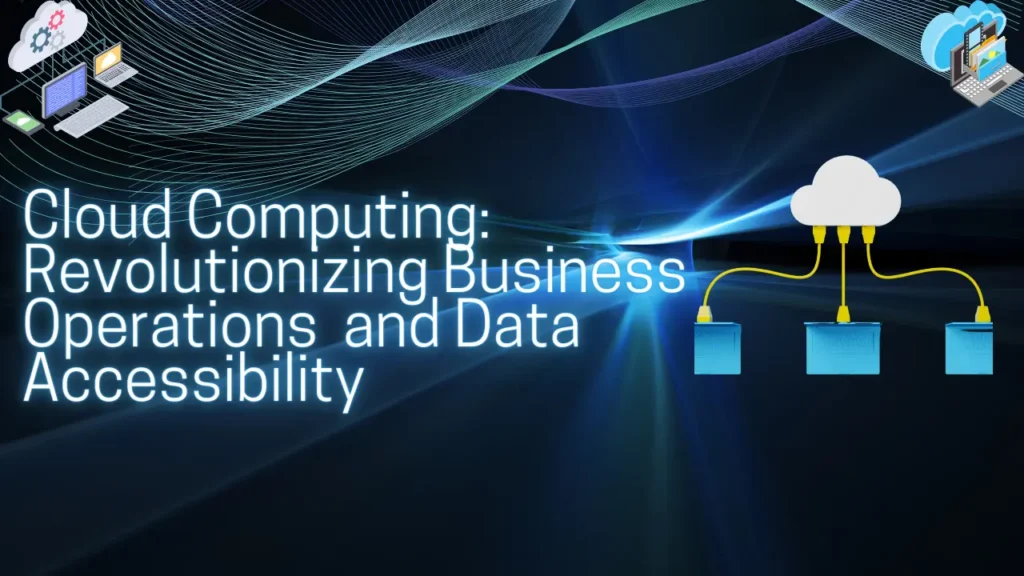Cloud computing has emerged as a revolutionary technology, transforming how businesses operate and individuals access and store data. This article will delve into cloud computing, exploring its various types, benefits, common services, and impact on businesses. By the end, you will comprehensively understand cloud computing and its potential for reshaping the digital landscape.
Introduction to Cloud Computing
Cloud computing refers to delivering computing services, including servers, storage, databases, networking, software, and analytics, over the Internet. Instead of relying on local servers or personal computers, cloud computing allows users to access and utilize these services remotely, on demand, and with greater flexibility.
Advantages of Cloud Computing
Cloud computing offers numerous advantages for businesses and individuals alike. Here are some key benefits:
Scalability and Flexibility
Cloud computing can scale resources up or down based on demand. It allows businesses to handle fluctuations in workload efficiently, ensuring optimal performance and cost savings.
Cost Savings
By leveraging cloud computing, businesses can eliminate the need for upfront infrastructure investments. Cloud services operate on a pay-as-you-go model, where users only pay for the resources they consume. This significantly reduces capital expenditures and enables cost savings.
Increased Collaboration
Cloud computing promotes collaboration by enabling teams to access shared resources, applications, and data from anywhere. It facilitates real-time collaboration, document sharing, and seamless communication, regardless of geographical location.
Disaster Recovery and Data Backup
Cloud services offer built-in data backup and disaster recovery mechanisms. Data is stored redundantly across multiple servers and locations, ensuring data resilience and quick recovery in case of failures or disasters.
Automatic Software Updates
Cloud computing providers regularly update their services with the latest features and security patches. Users can take advantage of these updates without worrying about manual installations or maintenance, ensuring they can access up-to-date software.
Disadvantages of Cloud Computing
While cloud computing brings numerous benefits, it also has disadvantages. Here are some potential drawbacks to consider:
Dependency on Internet Connectivity
Cloud computing heavily relies on internet connectivity. Users require a stable and high-speed internet connection to access cloud services effectively. This dependency can pose challenges in areas with limited or unreliable internet access.
Security and Privacy Concerns
Storing data in the cloud raises concerns about security and privacy. Organizations must trust cloud providers with their sensitive data and ensure robust security measures are in place. Data breaches and unauthorized access are potential risks that need to be addressed.
Limited Control and Customization
Cloud services often come with predefined configurations and limitations. Users may have limited control over the underlying infrastructure and software. Customization options may be restricted, which can challenge organizations with specific requirements.
Downtime and Service Reliability
Cloud services are subject to occasional outages or downtime. While providers strive to maintain high availability, unforeseen issues or maintenance activities can disrupt service temporarily. Organizations must consider potential downtime and its impact on their operations.
Data Portability Challenges
Migrating data between cloud providers or moving data back to on-premises infrastructure can be complex and time-consuming. Organizations must carefully plan and consider data portability before committing to a cloud service.
Benefits of Cloud Computing
Cloud computing offers numerous advantages for businesses and individuals alike. Some of the key benefits include:
Cost Efficiency
Cloud computing eliminates the need for upfront infrastructure investments, as users can scale resources up or down based on their requirements. It reduces operational and maintenance expenses, allowing for a pay-as-you-go model and optimizing overall expenditure.
Scalability and Flexibility
The cloud provides unparalleled scalability and flexibility, allowing businesses to adjust resources to match demand quickly. Whether increasing server capacity during peak times or scaling down during periods of low activity, the cloud offers agility and cost savings.
Increased Collaboration
With cloud-based collaboration tools, teams can work together seamlessly, irrespective of their physical location. Real-time document sharing, version control, and instant communication foster collaboration and enhance productivity.
Disaster Recovery
Cloud computing enables robust disaster recovery solutions. By storing data in multiple locations and implementing backup and redundancy strategies, businesses can minimize downtime and quickly recover from system failures or natural disasters.
Security
Contrary to common misconceptions, cloud computing provides robust security measures. Cloud service providers invest heavily in advanced security technologies, including encryption, access controls, and regular audits, ensuring data protection and compliance.
Common Cloud Computing Services
Cloud computing encompasses a range of services that cater to different needs. Some of the common services include:
Infrastructure as a Service (IaaS)
IaaS provides virtualized computing resources over the Internet, including virtual machines, storage, and networking capabilities. Users have control over the operating systems and applications they deploy, offering maximum flexibility and customization.
Platform as a Service (PaaS)
PaaS offers a platform for developers to build, deploy, and manage applications without worrying about the underlying infrastructure. It provides a ready-to-use development environment and simplifies the application lifecycle.
Software as a Service (SaaS)
SaaS delivers software applications over the Internet, eliminating the need for installation and maintenance. Users can access and use applications on-demand, paying for subscriptions or usage-based models.
Cloud Computing in Business
Cloud computing has transformed businesses’ operations, providing various solutions to enhance efficiency and productivity. Some key areas where cloud computing has made a significant impact include:
Cloud Storage and Backup
Cloud storage allows businesses to store and access data securely, eliminating the need for physical servers. Automatic backups, version control, and easy sharing enhance data management and facilitate collaboration.
Cloud-Based Applications
Cloud-based applications allow businesses to access software and tools from any device with an internet connection. This enables remote work, improves scalability, and reduces infrastructure costs.
Virtual Desktop Infrastructure (VDI)
VDI allows users to access virtual desktops hosted on the cloud, enabling remote access to applications and data. It enhances mobility and security and simplifies desktop management and maintenance.
Data Analytics and Artificial Intelligence (AI)
Cloud computing provides the computational power and storage required for advanced data analytics and AI applications. Businesses can leverage big data processing, machine learning, and predictive analytics to gain valuable insights and make informed decisions.
Challenges of Cloud Computing
While cloud computing offers numerous advantages, it also presents some challenges that need to be addressed:
Security Concerns
Data security remains a top concern for businesses considering cloud adoption. Organizations must ensure robust security measures, including encryption, access controls, and regular audits, to protect sensitive data from unauthorized access or breaches.
Downtime and Reliability
Reliance on the Internet and third-party service providers means cloud services are susceptible to downtime and outages. Organizations should have contingency plans and service level agreements to minimize any potential disruptions’ impact.
Vendor Lock-In
Once a business commits to a particular cloud service provider, it can be challenging to switch providers due to the proprietary nature of cloud platforms. Vendor lock-in can limit flexibility and increase switching costs.
Data Privacy and Compliance
Transferring data to the cloud raises concerns about data privacy and regulatory compliance. Organizations must ensure cloud service providers adhere to relevant data protection laws and industry-specific regulations.
Future Trends in Cloud Computing
Cloud computing continues to evolve, and several trends are shaping its future:
Edge Computing
Edge computing brings computation and data storage closer to the source of data generation, reducing latency and enhancing real-time processing capabilities. It enables faster response times and supports applications that require low latency, such as IoT and autonomous vehicles.
Serverless Computing
Serverless computing abstracts infrastructure management and allows developers to focus on code, improving productivity and scalability. Businesses can reduce costs and achieve greater operational efficiency by automatically managing resources.
Hybrid Cloud Adoption
Organizations are increasingly adopting hybrid cloud strategies, combining the benefits of public and private clouds. This approach allows businesses to leverage the advantages of both environments, ensuring optimal performance, security, and cost-effectiveness.
Multi-Cloud Strategy
To avoid vendor lock-in and maximize flexibility, businesses are adopting multi-cloud strategies, utilizing services from multiple cloud providers. This approach enables workload portability, risk diversification, and access to specialized services.
Conclusion
Cloud computing has revolutionized businesses’ operations, offering cost efficiency, scalability, collaboration, and advanced services. However, addressing security, reliability, and data privacy challenges is essential. As cloud computing continues to evolve, trends like edge computing, serverless computing, hybrid clouds, and multi-cloud strategies will shape its future. Embracing cloud computing can unlock new opportunities, streamline operations, and drive innovation.
FAQs
1. Is cloud computing suitable for small businesses?
Absolutely! Cloud computing offers scalability, cost savings, and flexibility, making it an ideal choice for small businesses. It allows them to access advanced technology and services without significant upfront investments.
2. How secure is cloud computing?
Cloud computing providers invest heavily in security measures to protect data. Encryption, access controls, regular audits, and compliance with industry regulations ensure robust security. However, businesses must also implement best practices to secure their data and applications.
3. Can I switch cloud service providers easily?
Switching cloud service providers can be challenging due to vendor lock-in and the proprietary nature of cloud platforms. It’s essential to carefully consider vendor selection and assess migration strategies to minimize disruptions.
4. What is the future of cloud computing?
The future of cloud computing involves trends like edge computing, serverless computing, hybrid clouds, and multi-cloud strategies. These trends aim to improve performance, efficiency, and flexibility, catering to evolving business needs.
5. How does cloud computing benefit individuals?
Cloud computing benefits individuals by providing easy access to applications, data, and services from any device with an internet connection. It enables remote work, enhances collaboration, and simplifies data storage and sharing.



